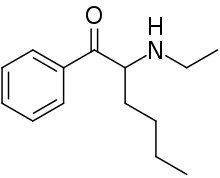N-Ethylhexedrone
N-Ethylhexedrone (also known as α-ethylaminocaprophenone, N-ethylnorhexedrone, hexen, and NEH) is a stimulant of the cathinone class[1][2] that acts as a norepinephrine–dopamine reuptake inhibitor (NDRI) with IC50 values of 0.0978 and 0.0467 μM, respectively.[3] N-Ethylhexedrone was first mentioned in a series of patents by Boehringer Ingelheim in the 1960s[4] which led to the development of the better-known drug methylenedioxypyrovalerone (MDPV).[5] Since the mid-2010s, N-ethylhexedrone has been sold online as a designer drug.[6][7][8] In 2018, N-ethylhexedrone was the second most common drug of the cathinone class to be identified in Drug Enforcement Administration seizures.[9]
 | |
| Legal status | |
|---|---|
| Legal status |
|
| Pharmacokinetic data | |
| Metabolism | Neurometabolic |
| Identifiers | |
| |
| CAS Number |
|
| PubChem CID | |
| ChemSpider | |
| UNII | |
| Chemical and physical data | |
| Formula | C14H21NO |
| Molar mass | 219.328 g·mol−1 |
| 3D model (JSmol) | |
| |
| |
Legal status
In the United States, N-ethylhexedrone is a Schedule I Controlled Substance.[10] N-Ethylhexedrone is illegal in Japan,[11] and is listed as a potentially harmful substance, but not banned in Sweden.[12][13] In December of 2019, the UNODC announced scheduling recommendations placing N-ethylhexedrone into Schedule II.[14]
See also
References
- Matsuta S, Katagi M, Nishioka H, Kamata H, Sasaki K, Shima N, et al. (2014). "Structural characterization of cathinone-type designer drugs by EI mass spectrometry". Japanese Journal of Forensic Science and Technology (in Japanese). 19 (2): 77–89. doi:10.3408/jafst.19.77.
- Kuś P, Rojkiewicz M, Kusz J, Książek M, Sochanik A (July 2019). "Spectroscopic characterization and crystal structures of four hydrochloride cathinones: N-ethyl-2-amino-1-phenylhexan-1-one (hexen, NEH), N-methyl-2-amino-1-(4-methylphenyl)-3-methoxypropan-1-one (mexedrone), N-ethyl-2-amino-1-(3,4-methylenedioxyphenyl)pentan-1-one (ephylone) and N-butyl-2-amino-1-(4-chlorophenyl)propan-1-one (4-chlorobutylcathinone)". Forensic Toxicology. 37 (2): 456–464. doi:10.1007/s11419-019-00477-y.
- Eshleman AJ, Nagarajan S, Wolfrum KM, Reed JF, Swanson TL, Nilsen A, Janowsky A (March 2019). "Structure-activity relationships of bath salt components: substituted cathinones and benzofurans at biogenic amine transporters". Psychopharmacology. 236 (3): 939–952. doi:10.1007/s00213-018-5059-5. PMC 6500773. PMID 30397775.
- DE 1545591, Herbert K, Karl Z, Gerhard L, "Verfahren zur Herstellung von α-Aminoketonen mit heterocyclischer Aminogruppe", published 28 May 1965, assigned to Boehringer Ingelheim
- Kolanos R, Solis E, Sakloth F, De Felice LJ, Glennon RA (December 2013). ""Deconstruction" of the abused synthetic cathinone methylenedioxypyrovalerone (MDPV) and an examination of effects at the human dopamine transporter". ACS Chemical Neuroscience. 4 (12): 1524–9. doi:10.1021/cn4001236. PMC 3867964. PMID 24116392.
- "2-(Ethylamino)-1-phenylhexan-1-one". New Synthetic Drugs Database. Archived from the original on 2017-05-20. Retrieved 2016-08-28.
- "Analytical Report - N-Ethylhexedrone" (PDF). European Project RESPONSE.
- Liu C, Jia W, Li T, Hua Z, Qian Z (August 2017). "Identification and analytical characterization of nine synthetic cathinone derivatives N-ethylhexedrone, 4-Cl-pentedrone, 4-Cl-α-EAPP, propylone, N-ethylnorpentylone, 6-MeO-bk-MDMA, α-PiHP, 4-Cl-α-PHP, and 4-F-α-PHP". Drug Testing and Analysis. 9 (8): 1162–1171. doi:10.1002/dta.2136. PMID 27863142.
- "Emerging Threat Report: Annual 2018" (PDF). Special Testing and Research Laboratory, Drug Enforcement Administration.
- "Schedules of Controlled Substances: Temporary Placement of N-Ethylhexedrone, α-PHP, 4-MEAP, MPHP, PV8, and 4-Chloro-α-PVP in Schedule I". Drug Enforcement Administration.
- "指定薬物一覧" [Designated drug list] (PDF) (in Japanese). Ministry of Health, Labour and Welfare.
- "31 nya ämnen kan klassas som narkotika eller hälsofarlig vara" [31 new substances can be classified as drugs or health hazardous products] (in Swedish). Folkhälsomyndigheten. 21 June 2016.
- "The Swedish Governments Official List Of Narcotics".
- "December 2019 – WHO: World Health Organization recommends 12 NPS for scheduling".